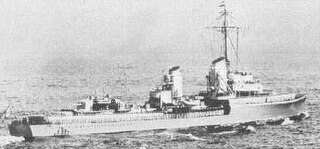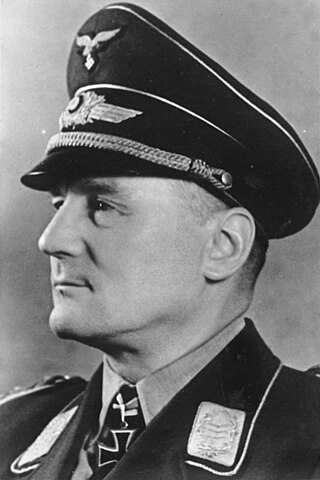
Wolfram Karl Ludwig Moritz Hermann Freiherr von Richthofen was a German World War I flying ace who rose to the rank of Generalfeldmarschall in the Luftwaffe during World War II.

The National Socialist Flyers Corps was a paramilitary aviation organization of the Nazi Party.

Between 1933 and 1945, the organization of the Luftwaffe underwent several changes. Originally, the German military high command, for their air warfare forces, decided to use an organizational structure similar to the army and navy, treating the aviation branch as a strategic weapon of war. Later on, during the period of rapid rearmament, the Luftwaffe was organized more in a geographical fashion.
Fliegerführer Afrika was part of Luftflotte 2, one of the primary divisions of the German Luftwaffe in the Second World War. It operated in the Mediterranean and Libya from 1941–1942. The commanders were Generalmajor Stefan Fröhlich and Generalleutnant Otto Hoffmann von Waldau, who led the German air support to the German Afrika Korps campaign during the winter of 1941–1942.

Operation Wikinger was a German naval sortie into the North Sea by six destroyers of the Kriegsmarine on 22 February 1940 during the Second World War. Poor inter-service communication and co-operation between the Kriegsmarine and the Luftwaffe resulted in the loss of two German warships through friendly fire bombing and German or British mines; the operation being cancelled. Only sixty survivors were recovered.

Stalingrad, a Soviet city and industrial centre on the river Volga, was bombed heavily by the Luftwaffe during the Battle of Stalingrad in World War II. German land forces comprising the 6th Army had advanced to the suburbs of Stalingrad by August 1942. The city was firebombed with 1,000 tons of high explosives and incendiaries in 1,600 sorties on 23 August. The aerial assault on Stalingrad was the most concentrated on the Ostfront according to Beevor. The destruction was monumental and complete, turning Stalingrad into a sea of fire and killing thousands of civilians and soldiers. Further fire-attacks were mounted against the ruined city for the next two days, enveloping it in dense volcano-like black smoke clouds that stretched 3.5 kilometers into the sky. At least 90% of the housing stock was obliterated.
Luftflotte 5 was one of the primary divisions of the German Luftwaffe in World War II. It was formed 12 April 1940 in Hamburg for the invasion of Norway. It transferred to Oslo, Norway on 24 April 1940 and was the organization responsible for Luftwaffe activity in Occupied Norway throughout the Second World War.
2nd Fighter Division was one of the primary divisions of the German Luftwaffe in World War II. It was formed 1 May 1942 in Stade The Division was disbanded on 8 May 1945. The Division was subordinated to XII. Fliegerkorps, I. Jagdkorps and IX (J) Fliegerkorps.
1st Fighter Division was one of the primary divisions of the German Luftwaffe in World War II. It was formed on 1 May 1942 in Deelen from Stab/1. Nachtjagd-Division and redesignated 3. Jagd-Division on 15 September 1943. It was immediately reformed on 15 September 1943 in Döberitz from the 4. Jagd-Division. The Division was subordinated to XII. Fliegerkorps, I. Jagdkorps and IX (J) Fliegerkorps.

Unternehmen Paula is the German codename given for the Second World War Luftwaffe offensive operation to destroy the remaining units of the Armée de l'Air (ALA), or French Air Force during the Battle of France in 1940. On 10 May the German armed forces (Wehrmacht) began their invasion of Western Europe. By 3 June, the British Army had withdrawn from Dunkirk and the continent in Operation Dynamo, the Netherlands and Belgium had surrendered and most of the formations of the French Army were disbanded or destroyed. To complete the defeat of France, the Germans undertook a second phase operation, Fall Rot, to conquer the remaining regions. In order to do this, air supremacy was required. The Luftwaffe was ordered to destroy the French Air Forces, while still providing support to the German Army.
2nd Air Corps was formed on 11 October 1939 in Frankfurt am Main from the 2. Flieger-Division. During Operation Barbarossa and from 22 June to 12 November 1941, the Corps flew over 40,000 day and night sorties, dropping 23,150 tons of bombs and claiming 3,826 Soviet aircraft destroyed as well as 789 tanks, 614 artillery pieces, 14,339 vehicles, 240 enemy field positions, 33 bunkers, 159 trains and 304 locomotives along with relentless attacks on enemy troop concentrations and logistical choke-points.
8th Air Corps was formed 19 July 1939 in Oppeln as Fliegerführer z.b.V.. It was renamed to the 8th Air Corps on 10 November 1939. The Corps was also known as Luftwaffenkommando Schlesien between 25 January 1945 and 2 February 1945 and was merged with Luftgau-Kommando VIII on 28 April 1945 and redesignated Luftwaffenkommando VIII.
I. Fliegerkorps was formed 11 October 1939 in Cologne from the 1st Air Division. The Corps was also known as Luftwaffenkommando Don between 26 August 1942 until 17 February 1943. It was transformed to the 18th Air Division on 4 April 1945.

IV. Fliegerkorps was formed 11 October 1939 in Düsseldorf from the 4. Flieger-Division. The Corps was disbanded on 16 September 1944 and its Stab formed the Kommandierenden General der Deutschen Luftwaffe in Dänemark.

X. Fliegerkorps was a formation of the German Luftwaffe in World War II, which specialised in coastal operations. It was formed 2 October 1939, in Hamburg from the 10. Flieger-Division.
IX. Fliegerkorps was formed in November 1940 in Jever from the 9. Flieger-Division and was redesignated as IX. Fliegerkorps (J)—the suffix "J" stands for Jagd —on 13 November 1944. The Corps at the time was leading numerous Kampfgeschwader which were converting to fighter aircraft. The Corps was renamed again on 26 January 1945, this time to IX. (J) Fliegerkorps.

Rudolf Meister was a German general in the Luftwaffe during World War II who commanded the 4th Air Corps. He was a recipient of the Knight's Cross of the Iron Cross of Nazi Germany. Meister surrendered to the American troops in May 1945 and was interned until 1948.

Axis and Soviet air operations during Operation Barbarossa took place over a six-month period, 22 June – December, 1941. Aviation played a critical role in the fighting on the Eastern Front during this period, in the battles to gain and maintain air superiority or air supremacy, to offer close air support to armies on battlefield, interdicting enemy supply lines, while supplying friendly forces. The Axis air forces were generally better equipped, trained and experienced in executing military tactics and operations. This superiority increased because of the Great Purge in the 1930s and mass expansion of Soviet air forces, which did severe damage to organisational structures.
Jagdgeschwader 234 was a fighter wing of Nazi Germany's Luftwaffe in World War II. It operated during peacetime and conducted formation flying, simulated aerial combat, and firing on ground targets. Many of its pilots came from Jagdgruppe 88 operating in Spain during the Spanish Civil War.









